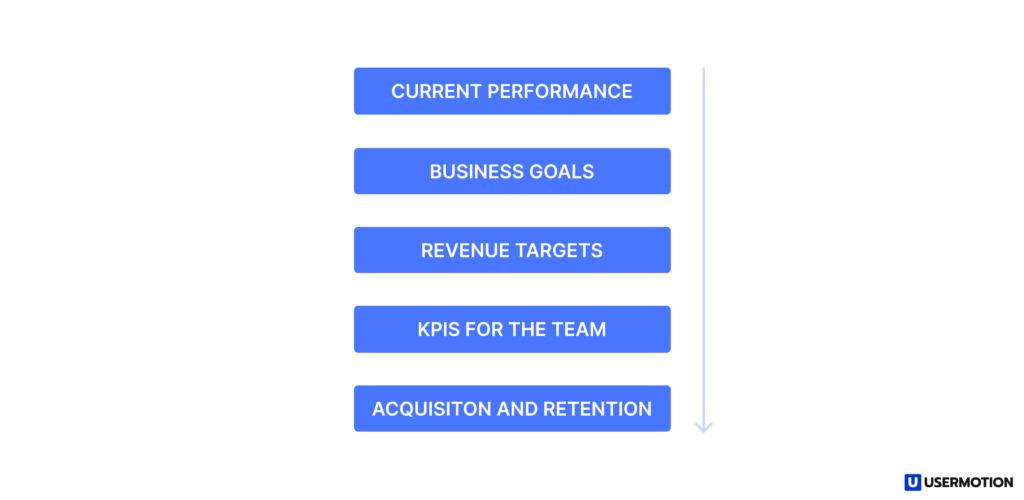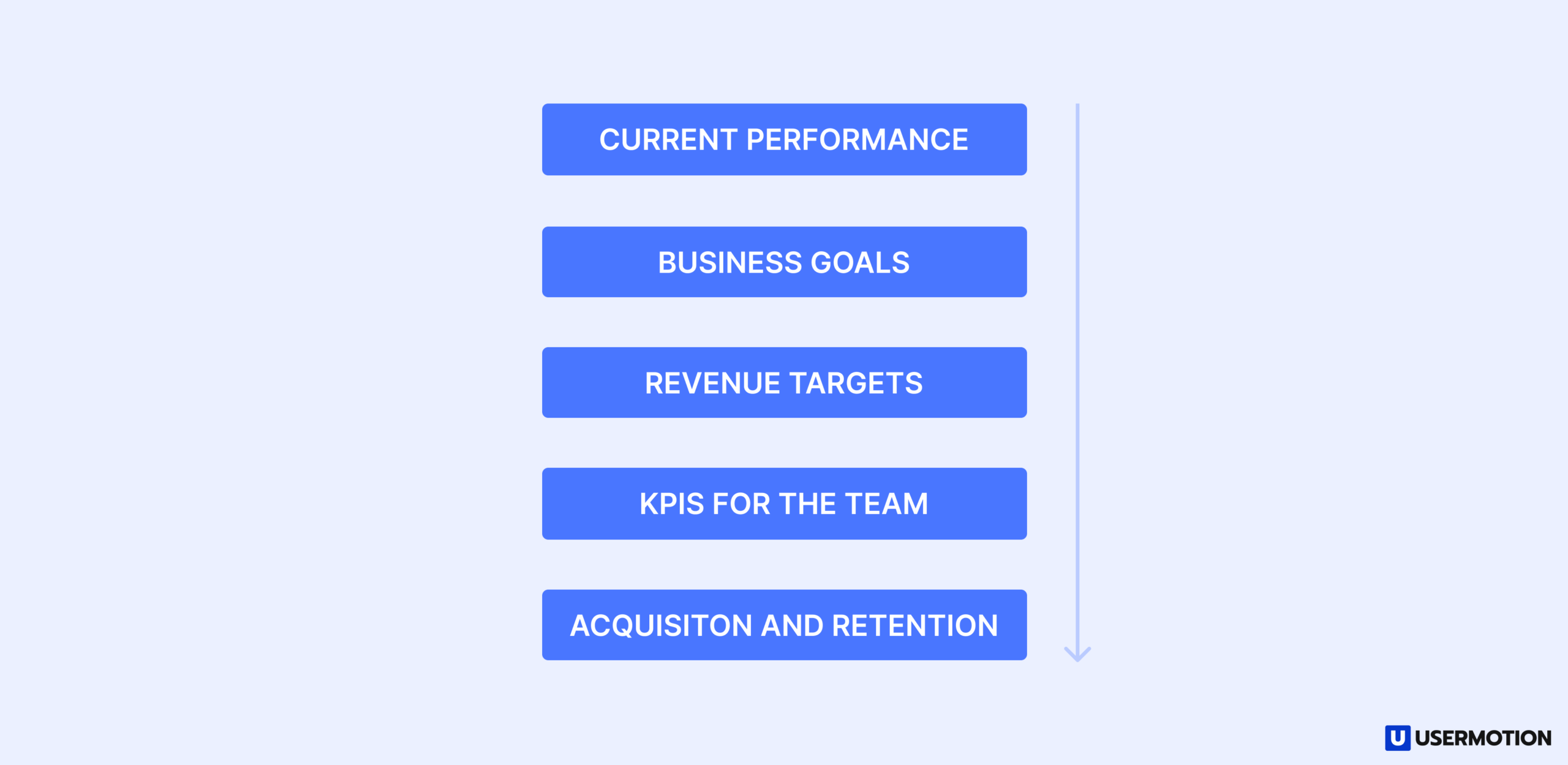In life and in business, setting clear and attainable goals is important. In fact, people who set goals are 43% more likely to achieve them.
When it comes to business, having a revenue goal is considered to be the greatest motivator and team alignment tool.
Why?
Revenue goals are measurable and help identify gaps in team performance, output, and top-to-down management.
It’s simple. Clear Targets = Better Business.
In this article, we’ll tell you the importance of setting solid revenue goals and a quick 5-step way in which you can do it for your business.
Let’s begin.
TL;DR
- Setting clear and measurable revenue goals is crucial for business success.
- Revenue goals are a compass, guiding operations and ensuring team alignment.
- You can set revenue goals in five simple steps.
- It all starts with measuring existing performance and your existing financials.
- The next step is analyzing business data and defining specific targets.
- The third step is breaking down annual targets into quarterly and monthly goals.
- The fourth step is to align team members with their specific roles in achieving revenue goals.
- Lastly, you need to plan for customer acquisition and retention strategies.
What Are Revenue Goals?
💡 Definition
Revenue goals mean the target financial position a company aims to earn. Setting up a revenue goal helps businesses to plan their growth strategy to reach their target making plans to increase sales, attract more customers, and grow the business to hit these financial targets.
A targeted revenue goal is a financial target for a specific period of time that can be tracked and measured throughout the said period.
For example, $7 million in gross sales for the third quarter of 2024 is a revenue goal example.
The process for creating revenue goals differs for each business, and it comes to many factors, such as product placement, market conditions, existing KPIs, and customer demand, among others.
Setting a revenue goal for your business can be tough, but it’s worth it. Let’s tell you why.
Why Setting Revenue Goals is Important
A clear and pre-planned revenue goal is the compass that guides business operations.
From ascertaining the scale of operation to thinking of customer acquisition and retention strategies, a revenue goal is the best tool for team realignment.
Apart from keeping everyone on the same page, a revenue goal is a great definition of business success. The quantifiable and measurable nature of these goals leaves no place to hide. Your business is either growing (goals met) or it isn’t (goals not met).
If you agree and need a clear process for setting revenue goals, then keep scrolling.
How To Set Revenue Goals

To set revenue goals, you must have the fundamentals straightened out—your ICP, current expansion plans, business models, etc. Once you have the basics right, goal setting becomes a simple numbers game. Here’s how you can set clean and trackable revenue goals for your business.
1. Measure Existing Performance
Let’s assume you sell a software service in the CRM niche. Here are some of the questions you need to ask:
- How many customers do I currently have?
- What is my churn rate?
- What has been my MRR over the past year?
- What is the conversion rate at each stage of the sales funnel?
With this data, you can measure your existing growth circuit and make a reliable bet on the future with a slightly incremental revenue goal.
2. Analyze Business Goals & Team Capacity
The revenue goal must align with your business goal for the year.
- Is there a new expansion plan or product launch on the horizon?
- Are you planning to scale your services and customer touch points?
- Are you planning to simply strengthen your bottom line?
To scale operations, your existing team might not be enough. Adding new members is a time-consuming process that might divert your attention from the business.
When setting revenue goals, you need to account for extra hours and resources that might go into scaling your team.
3. Define Specific Revenue Targets
An annual target, split into quarterly and monthly targets, is the best way to set your targeted revenue goal.
Splitting revenue goals into monthly targets allows you to account for the impact of churn, giving you a more accurate picture of the revenue you need to generate to offset customer losses.
Monthly and quarterly targets provide flexibility for your sales and customer success teams to adapt to changing conditions, whether there’s an upward or downward trend in revenue.
Lastly, quarterly goals act as checkpoints that allow you to review your strategies and make necessary adjustments based on the results achieved during the previous period.
4. Set KPIs for the Team
Once you have the targets in place, it’s time to bring them down to each team member.
Breaking down annual revenue targets into specific activities and team assignments will help set revenue goals in a structured and actionable manner.
Once we have the bifurcation, team members have an alignment over overarching objectives and execution.
5. Plan For Customer Acquisition and Retention Strategies
You have the target in place and know what your team members and processes are tasked with bringing, but what about customer acquisition?
The most important step in setting a revenue goal is thinking about your customer acquisition plan. You need a lead pipeline, a sales funnel, and a sales team to acquire new buyers. And you need a sophisticated lead scoring tool that collects the top-of-the-cream leads for your business.
A PLG CRM solution like UserMotion analyzes your ICP and filters leads with the highest chance of conversion. You can Integrate your ICP from data tools like HubSpot and have high-value leads sent directly to your sales representative – without lifting a finger.
Conclusion
Setting your targeted revenue goals might be one of the most important tasks you need to take care of in business, regardless of its type or scale of operation. So, whether you’re a startup, a growing enterprise, or an established corporation, remember that well-defined revenue goals are the single most effective way to measure your business’ upward trajectory and make sure that your team is on the right path.
Step into the new year with clear revenue goals. Need help in ranking and prioritizing your leads for optimum conversion and reduced CPA? Check out our premium AI-based lead scoring software today.
Frequently Asked Questions
What is a revenue goal?
A revenue goal is a specific target that is set to be achieved over the course of a period. The target is set in the purview of how much a business wishes to earn and progress in the coming time. The revenue goal focuses on gross sales and includes operational costs, expenses, and taxes.
How often should I review and adjust revenue goals?
To stay on track with your goals, it’s best to do reviews every month and every three months. When there are a lot of changes in a market like SaaS, it’s important to review things on a regular basis so you can change your plans and stay on track with your income goals.
How can setting revenue goals benefit my business’s growth and success?
Setting revenue goals benefits a business by providing a clear direction and motivating teams toward a common objective. These goals offer measurable progress and reveal performance gaps, which allows you to focus on strategic aspects like customer acquisition and retention.





